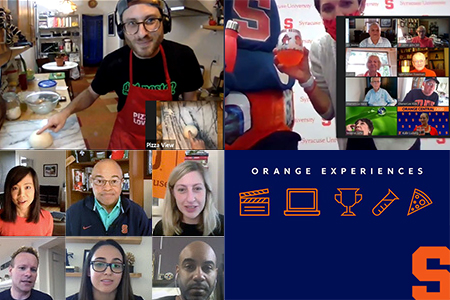Painting the Globe Orange in a Virtual World

With more than 260,000 alumni living in 171 countries around the globe, the challenges posed by a global pandemic presented opportunities for those teams responsible for engaging alumni in programs and events.
“We had to build the plane as we flew it,” says Cory Miller, executive director of events and affinity programs for the Office of Alumni Engagement. “Most of us had never done a completely virtual event before. We all had to learn an entirely new skillset.”
But it was all so worth it, judging from the feedback from grateful alumni. “We included many folks who would not have been able to come via long distance planes, trains or cars,” wrote a member of the Class of 1960 in praise of Virtual Orange Central 2020. “For some, it would have been a real challenge…I've been a part of planning and facilitating major conferences over many years -- this was a lovely A+ experience.” Nearly 1,300 alumni participated in the weekend celebration, which included more than 30 live programs as well as 15 pre-recorded programs that provided an on-demand track for alumni from any time zone to participate.
Endearingly called the Brady Bunch experience by those putting together virtual events, this brave new world of alumni engagement is not for the faint of heart. “Dependence on technology means you always have to have a Plan B, and a back-up plan to the back-up plan,” says Miko Horn ’95, director of alumni events for the Office of Multicultural Advancement.
But going virtual meant being able to reach alumni who were engaging for the very first time in Orange events, and thousands of others aching for meaningful social connections while coping with the isolation forced upon them by the pandemic. “When we host our traditional Coming Back Together event for alumni on campus, you can see people hugging each other. The emotional connections are obvious,” says Horn. “We had to figure out the best ways to use technology platforms to make those same emotional connections.” Clearly, they figured it out. They managed to squeeze what was traditionally a four-day on-campus event into 13 hours of programming, across multiple time zones. The Virtual CBT 2020 featured programming, parties and a telethon that raised more than $800,000 in contributions and pledges. “The virtual world brought lots of love, laughter, tears, healing, hope and inspiration,” says Horn.
The reunion was the culmination of CBT programs and events that engaged more than 7,000 alumni in a Virtual Connection Series launched last May. “People are busy, but they are looking for quality content,” says Horn. They covered topics as wide-ranging as yoga and cooking, to politics and wealth building. They took on contemporary and controversial issues especially impacting people of color, including a historic look at The Syracuse 8 that promised to “offer healing and understanding during this moment of racial unrest in America.”
Miller says the vast amount of virtual programming that was produced by the Office of Alumni Engagement featured and attracted alumni from around the world—including many who would never have been able to travel to Syracuse to renew their ties to the Orange community any other way. “Engaging the international community of alumni has been an epic change for us,” says Miller. The Orange Experience Series, including nine virtual programs last fall, is an interactive virtual learning experience in topics ranging from the science of mindfulness and HIIT cardio to the perfect wine pairing. “I recall one alum joining us from Florence, Italy, for our program ‘Making the Perfect At-Home Pizza.’ It was 1 a.m. her time! And then there’s the woman from Costa Rica who teared up during her Orange Central 60th reunion. She said she would never have been able to be part of it if she had had to travel to Syracuse, due to both health and economic reasons.”
The Council for Advancement and Support of Education (CASE) recently recognized Syracuse University with a Bronze award for its efforts to connect with alumni virtually in a program called Orange Night In. Alumni who signed up to participate were given an all-digital kit that included trivia cards to test their knowledge of all things Orange; recipes for Orange-themed appetizers, desserts, cocktails and mocktails; a list of movies and TV shows (and where they are streaming) featuring alumni actors and directors; and even an Otto coloring page for kids.
“In this virtual world, we became more creative than ever before,” says Miller. “We are encouraged and challenged to think outside the box. And it’s strengthened partnerships, like with Hendricks Chapel. Holidays at Hendricks is the kind of event that people don’t travel to from around the country. Virtually, we had more than 2,000 viewers watching the YouTube premier featuring the chapel choir and other performers. It was so meaningful and uplifting.”
In fact, during the fall, virtual programs attracted alumni from South America, USVI, Mexico, Albania, China, Czech Republic, Germany, Greece, Hong Kong, India, Italy, Japan, Pakistan, South Korea, Turkey, United Arab Emirates, UK, Italy, Panama, and Costa Rica.
Both Miller and Horn agree that virtual alumni programs and events will continue well beyond the pandemic to sustain and strengthen the alumni network. “The fact is that we had the technology before the pandemic. The invention was there,” says Miller. “The pandemic inspired the creativity to seize the invention and make it work for the Orange community. It truly feels like the world is our oyster now. And none of us, including our alumni, are going to want to give this up.”
